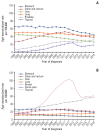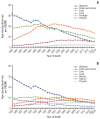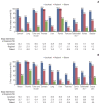Cancer Statistics in Korea: Incidence, Mortality, Survival, and Prevalence in 2018 - PubMed (original) (raw)
Cancer Statistics in Korea: Incidence, Mortality, Survival, and Prevalence in 2018
Seri Hong et al. Cancer Res Treat. 2021 Apr.
Abstract
Purpose: The current study provides national cancer statistics and their secular trends in Korea, including incidence, mortality, survival, and prevalence in 2018.
Materials and methods: Incidence, survival, and prevalence rates of cancer were calculated using the Korea National Cancer Incidence Database, from 1999 to 2018, with survival follow-up until December 31, 2019. Deaths from cancer were assessed using causes-of-death data obtained from Statistics Korea. Crude and age-standardized rates (ASRs) for incidence, mortality, prevalence, and 5-year relative survival rates were calculated, and temporal trends for incidence and mortality rates were evaluated, with annual percentage changes.
Results: In 2018, newly diagnosed cancer cases and deaths from cancer were reported as 243,837 (ASR, 270.4 per 100,000) and 79,153 (ASR, 73.3 per 100,000), respectively. The overall cancer incidence rates increased by 3.3% annually from 1999 to 2012, and decreased by 5.4% annually from 2012 to 2015, thereafter, followed by nonsignificant changes. Cancer mortality rates have been decreasing since 2002, with more rapid decline in recent years (annual decrease of 2.7% from 2007 to 2014; 3.7% from 2014 to 2018). The 5-year relative survival between 2014 and 2018 was 70.3%, which contributed to prevalent cases reaching over 2 million by the end of 2018.
Conclusion: Cancer statistics have improved significantly during the past two decades. However, there remain important challenges to be solved, such as controlling cancers with low survival rates. Cancer statistics can be used to discover blind spots in cancer control, and as evidence for developing and implementing future cancer control strategies.
Keywords: Incidence; Korea; Mortality; Neoplasms; Prevalence; Survival.
Conflict of interest statement
Conflicts of Interest
Conflict of interest relevant to this article was not reported.
Figures
Fig. 1
The five common sites of cancer incidence by age group and sex in Korea, 2018. (A) Men. (B) Women. Numbers in the graph are age-specific incidence rates per 100,000. CNS, central nervous system.
Fig. 2
Age-specific incidence rates of common cancers for 2018 in Korea. (A) Men. (B) Women.
Fig. 3
Annual age-standardized cancer incidence and mortality rates by sex for all sites from 1983 to 2018 in Korea. Age standardization was based on Segi’s world standard population.
Fig. 4
Trends in age-standardized incidences of selected cancers by sex from 1999 to 2018 in Korea. (A) Men. (B) Women. Age standardization was based on Segi’s world standard population.
Fig. 5
Trends in age-standardized mortalities of selected cancers by sex from 1983 to 2018 in Korea. (A) Men. (B) Women. Age standardization was based on Segi’s world standard population. a)Cancers of cervix uteri, corpus uteri, and unspecified parts of the uterus were combined (C53–C55), due to their unclear classifications in the past.
Fig. 6
Five-year relative survival rates by stage at diagnosis and stage distribution of selected cancers by sex in Korea, 2014–2018. (A) Men. (B) Women. Staging according to the Surveillance, Epidemiology, and End Results (SEER) stage categories. For each cancer type, stage categories do not total 100% because sufficient information was not available to stage all cases. a)Includes the gallbladder and other/unspecified parts of the biliary tract.
Fig. 7
Prevalent cases of common cancers by time since cancer diagnosis. Prevalent cases were defined as the number of cancer patients alive on January 1, 2019 among all cancer patients diagnosed between 1999 and 2018.
Similar articles
- Cancer Statistics in Korea: Incidence, Mortality, Survival, and Prevalence in 2017.
Hong S, Won YJ, Park YR, Jung KW, Kong HJ, Lee ES; Community of Population-Based Regional Cancer Registries. Hong S, et al. Cancer Res Treat. 2020 Apr;52(2):335-350. doi: 10.4143/crt.2020.206. Epub 2020 Mar 16. Cancer Res Treat. 2020. PMID: 32178489 Free PMC article. - Cancer Statistics in Korea: Incidence, Mortality, Survival, and Prevalence in 2019.
Kang MJ, Won YJ, Lee JJ, Jung KW, Kim HJ, Kong HJ, Im JS, Seo HG; Community of Population-Based Regional Cancer Registries. Kang MJ, et al. Cancer Res Treat. 2022 Apr;54(2):330-344. doi: 10.4143/crt.2022.128. Epub 2022 Mar 16. Cancer Res Treat. 2022. PMID: 35313102 Free PMC article. - Cancer Statistics in Korea: Incidence, Mortality, Survival, and Prevalence in 2020.
Kang MJ, Jung KW, Bang SH, Choi SH, Park EH, Yun EH, Kim HJ, Kong HJ, Im JS, Seo HG; Community of Population-Based Regional Cancer Registries*. Kang MJ, et al. Cancer Res Treat. 2023 Apr;55(2):385-399. doi: 10.4143/crt.2023.447. Cancer Res Treat. 2023. PMID: 36915245 Free PMC article. - Attributable fraction of tobacco smoking on cancer using population-based nationwide cancer incidence and mortality data in Korea.
Park S, Jee SH, Shin HR, Park EH, Shin A, Jung KW, Hwang SS, Cha ES, Yun YH, Park SK, Boniol M, Boffetta P. Park S, et al. BMC Cancer. 2014 Jun 6;14:406. doi: 10.1186/1471-2407-14-406. BMC Cancer. 2014. PMID: 24902960 Free PMC article. Review. - Basic Facts of Breast Cancer in Korea in 2014: The 10-Year Overall Survival Progress.
Park EH, Min SY, Kim Z, Yoon CS, Jung KW, Nam SJ, Oh SJ, Lee S, Park BW, Lim W, Hur MH; Korean Breast Cancer Society. Park EH, et al. J Breast Cancer. 2017 Mar;20(1):1-11. doi: 10.4048/jbc.2017.20.1.1. Epub 2017 Mar 24. J Breast Cancer. 2017. PMID: 28382089 Free PMC article. Review.
Cited by
- Risk score model for predicting mortality among patients with lung cancer.
Huh Y, Kim HR, Kim HJ, Son KY. Huh Y, et al. Front Med (Lausanne). 2024 Oct 14;11:1400049. doi: 10.3389/fmed.2024.1400049. eCollection 2024. Front Med (Lausanne). 2024. PMID: 39473493 Free PMC article. - Machine learning-based prediction of pulmonary embolism to reduce unnecessary computed tomography scans in gastrointestinal cancer patients: a retrospective multicenter study.
Kim JS, Kwon D, Kim K, Lee SH, Lee SB, Kim K, Kim D, Lee MW, Park N, Choi JH, Jang ES, Cho IR, Paik WH, Lee JK, Ryu JK, Kim YT. Kim JS, et al. Sci Rep. 2024 Oct 25;14(1):25359. doi: 10.1038/s41598-024-75977-y. Sci Rep. 2024. PMID: 39455658 Free PMC article. - Height and breast cancer risk in premenopausal Korean women aged under 40 years of age.
Tran TXM, Chang Y, Choi HR, Kwon R, Lim GY, Cho Y, Ryu S, Park B. Tran TXM, et al. Br J Cancer. 2024 Oct 7. doi: 10.1038/s41416-024-02846-w. Online ahead of print. Br J Cancer. 2024. PMID: 39375531 - Impact of early economic activity loss on all-cause mortality in gastric cancer survivors following curative treatment: a nationwide study in Korea.
Yun B, Oh J, Park H, Chung J, Sim J, Lee J, Kim Y, Yoon JH. Yun B, et al. Gastric Cancer. 2024 Nov;27(6):1159-1168. doi: 10.1007/s10120-024-01541-2. Epub 2024 Aug 12. Gastric Cancer. 2024. PMID: 39133396 - Detection and Characterization of Methylated Circulating Tumor DNA in Gastric Cancer.
Seo SY, Youn SH, Bae JH, Lee SH, Lee SY. Seo SY, et al. Int J Mol Sci. 2024 Jul 5;25(13):7377. doi: 10.3390/ijms25137377. Int J Mol Sci. 2024. PMID: 39000483 Free PMC article.
References
- World Health Organization. WHO report on cancer: setting priorities, investing wisely and providing care for all. Geneva: World Health Organization; 2020.
- Ajiki W, Tsukuma H, Oshima A. Index for evaluating completeness of registration in population-based cancer registries and estimation of registration rate at the Osaka Cancer Registry between 1966 and 1992 using this index. Nihon Koshu Eisei Zasshi. 1998;45:1011–7. - PubMed
- Statistics Korea [Internet] Daejeon: Statistics Korea; 2019. [cited 2021 Feb 28]. Available from: http://kosis.kr.
Publication types
MeSH terms
LinkOut - more resources
Full Text Sources
Other Literature Sources
Miscellaneous






